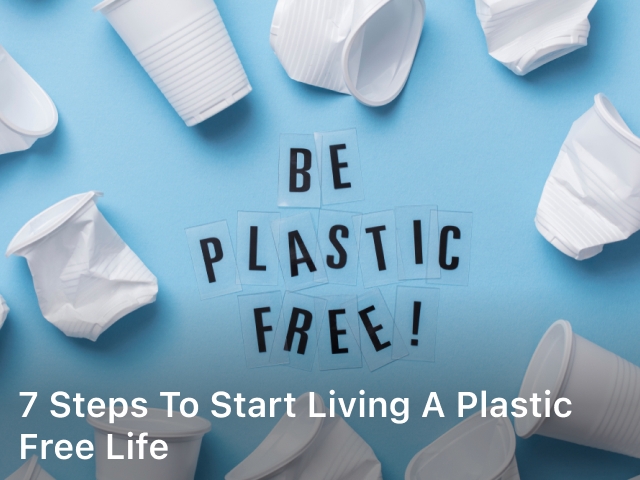
7 Steps to Start Living a Plastic Free Life – Discover the 7 essential steps to embark on a plastic-free journey. Learn how to reduce plastic waste and make eco-conscious choices for a sustainable future.
In today’s world, where plastic pollution is a growing concern, taking steps to live a plastic-free life is not just a choice; it’s a responsibility. By making conscious decisions, we can significantly reduce our plastic consumption and its detrimental impact on the environment.
In this comprehensive guide, we’ll explore the “7 Steps to Start Living a Plastic Free Life.” Join us on this eco-friendly journey and make a positive change for our planet.
What is the meaning of plastic-free lifestyle?
A plastic-free lifestyle refers to a way of living in which individuals consciously and intentionally reduce or eliminate their use of plastic products and materials in various aspects of their daily lives.
The goal of adopting a plastic-free lifestyle is to minimize the negative environmental impacts associated with plastic production, use, and disposal. This lifestyle involves making choices and taking actions to reduce plastic consumption, waste, and pollution.

Living a Plastic Free Life
1. Assess Your Plastic Usage
To begin your plastic-free journey, you need to understand your current plastic consumption. Take a moment to evaluate your daily routine, noting where plastic is most prevalent. This self-awareness will serve as the foundation for your eco-conscious lifestyle.
2. Replace Single-Use Plastics
Single-use plastics, like plastic bags and disposable cutlery, contribute significantly to pollution. Swap these items for reusable alternatives such as cloth bags, stainless steel straws, and bamboo utensils. These simple switches can make a big difference.
3. Embrace Sustainable Packaging
Choose products with eco-friendly packaging. Look for items in glass, metal, or cardboard containers. By supporting companies that prioritize sustainable packaging, you promote a greener future.
4. Reduce Food Packaging
Minimize plastic in your kitchen by buying food in bulk and using reusable containers. Opt for fresh produce instead of pre-packaged goods. These choices not only reduce plastic waste but also promote healthier eating habits.
5. Eco-Friendly Personal Care
Swap plastic-laden personal care products for natural alternatives. Use shampoo bars, wooden toothbrushes, and refillable skincare products. Your body and the environment will thank you.
6. Plastic-Free Cleaning
Household cleaning often involves plastic bottles and disposable wipes. Transition to plastic-free cleaning by making your own cleaning solutions or purchasing eco-friendly cleaning products in recyclable containers.
7. Spread Awareness
Becoming an advocate for a plastic-free lifestyle is essential. Educate your friends and family about the impact of plastic pollution and share your journey on social media. Small actions can inspire significant change.
Now that you’ve learned the seven crucial steps to reduce your plastic footprint, it’s time to put them into action. By incorporating these changes into your daily life, you’ll not only minimize plastic waste but also inspire others to follow suit.
Can you live a life without plastic?
Living a life entirely without plastic in the modern world is extremely challenging, but it is possible to significantly reduce your plastic consumption and minimize your plastic footprint.
While eliminating all plastic use may not be feasible due to its prevalence in our daily lives, you can take steps to reduce your reliance on plastic and make more sustainable choices.
Here are some ways to approach a low-plastic lifestyle:
- Focus on Essentials: Identify the essential plastic items in your life that are difficult to replace, such as medical equipment, electronics, or safety gear. These are instances where plastic serves crucial purposes, and alternatives may not be readily available.
- Prioritize Reusables: Whenever possible, opt for reusable items instead of disposable ones. This includes using reusable shopping bags, water bottles, and food containers. By choosing durable, long-lasting products, you reduce the need for disposable plastic.
- Explore Plastic-Free Alternatives: Seek out products and brands that offer plastic-free or low-plastic alternatives. Many companies now produce eco-friendly options, such as bamboo toothbrushes, metal safety razors, and cloth diapers.
- Shop in Bulk: Purchase items like grains, nuts, and spices from bulk bins using your reusable containers. This reduces the amount of plastic packaging associated with these products.
- Support Sustainable Packaging: Choose products that come in sustainable packaging, such as glass, paper, or metal. Be mindful of the packaging materials used for the products you buy.
- Reduce Fast Food and Takeout: The fast-food industry is a significant source of single-use plastics. Reducing your consumption of fast food and takeout can greatly reduce your plastic waste.
- Make Homemade Items: Consider making your own cleaning supplies, personal care products, and even some food items. Homemade versions often involve fewer or no plastic containers.
- Compost: Utilize composting for organic waste, which can help reduce the amount of plastic waste going to landfills.
- Support Legislation and Advocacy: Advocate for policies and regulations that promote plastic reduction and recycling. Support organizations working to combat plastic pollution.
- Spread Awareness: Share your journey to a low-plastic lifestyle with friends and family to inspire them to make similar changes. Collective efforts can have a more significant impact.
While it may not be feasible to completely eliminate plastic from your life, taking steps to reduce your plastic usage can have a meaningful and positive impact on the environment. Remember that small changes add up, and your efforts contribute to the broader movement to reduce plastic pollution.
Frequently Asked Questions
Q: How can I convince my family to adopt a plastic-free lifestyle?
A: Start by sharing the environmental benefits and cost savings. Lead by example and involve them in the transition.
Q: Are there any affordable alternatives to plastic-free products?
A: Yes, many budget-friendly eco-friendly options are available. Look for local stores and online retailers that offer affordable choices.
Q: What should I do with the plastic items I already own?
A: Use them until they wear out, then dispose of them properly by recycling or repurposing.
Q: Can I still enjoy takeout food without contributing to plastic waste?
A: Absolutely! Carry your own reusable containers and utensils, and inform restaurants about your preference for minimal plastic packaging.
Q: How can I make sure my efforts have a significant impact on reducing plastic pollution?
A: By sharing your journey on social media, encouraging others to join, and supporting legislation against plastic pollution, you can amplify your impact.
Q: Is it possible to live entirely plastic-free in today’s world?
A: While it can be challenging to eliminate all plastic, reducing your usage and making conscious choices are meaningful steps toward a plastic-free life.
Embarking on a plastic-free journey is not only beneficial for the environment but also for your well-being. By following the “7 Steps to Start Living a Plastic Free Life,” you can reduce your ecological footprint and inspire others to do the same. Let’s work together to create a cleaner, healthier planet for future generations.




